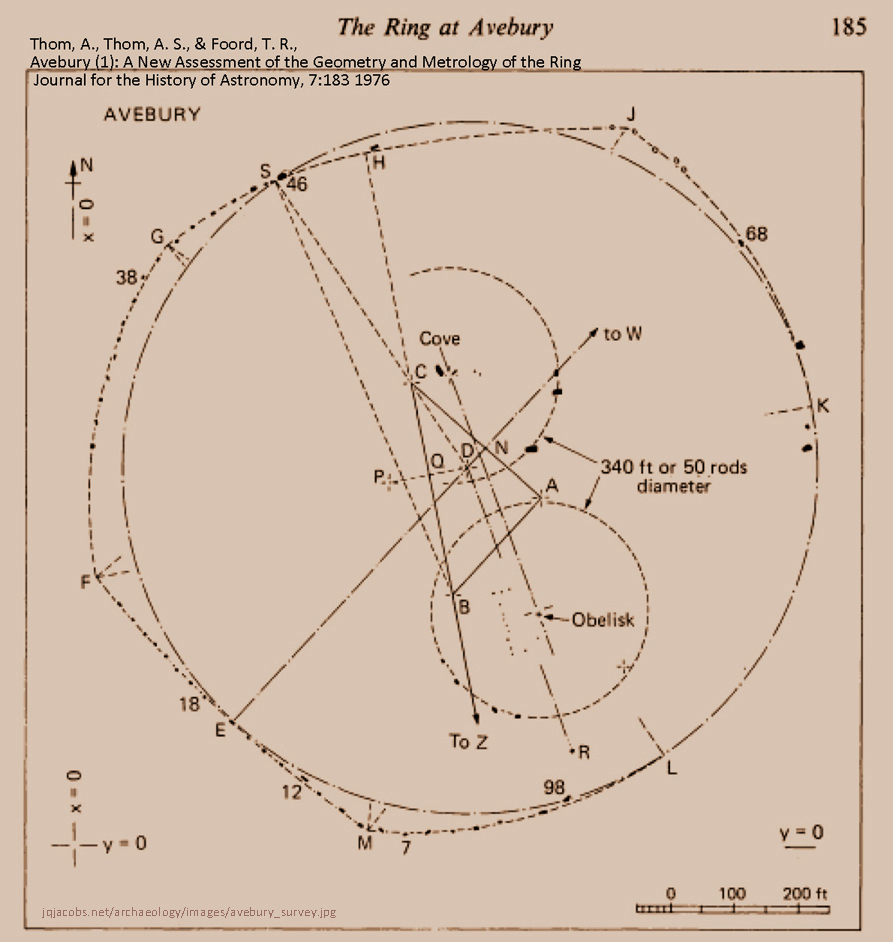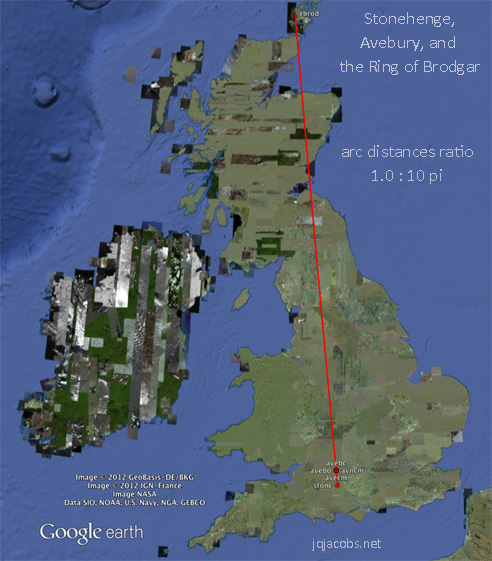
ArchaeoBlog - Pi Day 2012
2012.03.14 - Pi appeared while considering the arc distances between the largest Neolithic stone circles and Stonehenge. The pi numeric string expressing the ratio of arc distances between three sites previously occurred in relation to Stonehenge. Pi has also surfaced when considering astronomy correlations and monument properties. In this most recent instance, the accuracy of the ratio is so impressive a question is posed, "Did the Neolithic builders of the megalithic stone circles intend to express pi?"
The largest stone circles include the very largest, Avebury, the outstanding outlier at 344 meters in diameter. Another half-dozen stone rings nearer 100 to 115 meters in diameter comprise the "great stone circles," large outliers among the nearly one thousand smaller circles. The great stone circles include Newgrange, Long Meg, the Ring of Brodgar, Stanton Drew, and the two inner circles within the massive Avebury circle and surrounding henge. While the great circles are geographically dispersed, most certainly they are not independent inventions. While it is unlikely to be coincidental that five of the seven have near the same diameters, precise placements on the landscape to express pi is both a far more difficult task and an ability not commonly attributed to Neolithic cultures.

Geodetic science and the ability to accurately determine the coordinates of ancient monuments is itself a recent development. The current world geodetic system, adopted in 1984 (WGS84), readily allows accurate determination of the relationships of points across the globe. In recent years, the Global Positioning System (GPS) and Google Earth (GE) aerial and satellite imagery have facilitated accurate geographic definition of monument coordinates. Individual megaliths are clearly visible in Google Earth today. Recent Google Earth image updates provided the coordinate data in Table 1 (refining previous coordinate data).
|
Table 1. The Neolithic Monuments Considered.
|
Site |
Latitude |
Longitude |
Code |
Stonehenge |
51.178865 |
-1.826189 |
stonc |
Ring of Brodgar |
59.001476 |
-3.229740 |
rbrod |
Avebury Obelisk |
51.428035 |
-1.853392 |
avebo |
Avebury Cove Megalith |
51.429087 |
-1.854061 |
avebc |
Avebury Circles Mean |
51.428561 |
-1.853727 |
avecm |
The arc distances ratio of 1.0 to 31.4168 caught my attention when Stonehenge, Ring of Brodgar, and Avebury were the three site variables in my research applet, archaeogeodesy.xls. Avebury's "centerpoint" is a bit ambiguous because the "circle" is not a true circle. The Cove and the Obelisk are internal features of the two Avebury inner circles. While these immense menhirs are not necessarily the precise centers of their respective circles, the mean of the two immense stones (avecm) approximates one plausible center for Avebury while providing a reference to specific stone settings. Avebury's north inner circle (an ellipse with the central Cove setting) and south inner circle (with the central Obelisk) are sized nearly the same diameter as the Ring of Brodgar, a true circle. Accuracy of pi is expressed with greater refinement than the methodology employed to determine the coordinates. The margin of error in determining coordinates exceeds the error factor in the hypothetical representation of pi.

Download Google Earth placemarks file: stonehenge_pi.kml
Move the centerpoint at Avebury less than a meter from the avecm coordinate, and the value '10 pi' is precise! Avebury is about one-quarter degree from Stonehenge, almost 28,000 meters to the north and just over 3,000 meters west. The Stonehenge to Brodgar center-on-center arc distance of 875,200 meters is known within a few meters accuracy, say within 10 meters. Divide 875,200m by 31.4159 and the hypothetical Avebury to Stonehenge arc is thus determined to an accuracy of plus or minus 2/3 meter. From the center of Stonehenge, that line (27,857.4 +/- 0.3m) lands not only precisely between the Cove and the Obelisk but also within a meter of latitude equaling one-seventh of circumference.
There is no doubt pi is irrational. Is it also irrational to assume the builders intended this 10 pi distance ratio? The implication of the intentional hypothesis is counter paradigmatic, implying that by 4,500 years ago the builders knew the value of pi and either precisely surveyed the British Isles or could astronomically point-position accurately. It would be easy to dismiss this as coincidence were it not so precise.
Precision is a valuable tool when doing statistics on a sample of one (the only statistical tool that comes to mind for samples of one). Having independent probabilities is another useful tool for probability analysis. To determine the probability of two coincidences, each probability is multiplied by the other, resulting in an astronomical number. Is it also a coincidence that Avebury, the largest stone circle with three of the great stone circles, is so accurately situated at one-seventh of circumference latitude?

You can test these ideas and other numbers yourself with my applets, downloads: Astronomy Page
Further reading related to these ideas: Ancient Astronomy, Integers, Great Ratios, and Aristarchus
Stonehenge and Astronomy | Return to the ArchaeoBlog.

Afterwords
2012.08.13 - Mark Vidler did the math for himself to test the ideas above and noted I confused two numbers. Thanks for the correction Mark. |